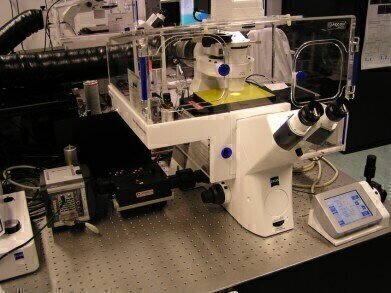-
 CLF's Octopus Imaging facility
CLF's Octopus Imaging facility
News & Views
Designer Nanomaterials Caught by Laser Octopus
Jun 29 2016
Researchers from the University of Bristol working with a team from the Science and Technology Facilities Council’s Central Laser Facility, UK have found a way of identifying two-dimensional nanomaterials, called platelet micelles, using the super resolution imaging of the STFC’s microscope facility ‘Octopus’.
Platelet micelles consisting of three concentric rectangles, each incorporating fluorescent dyes of a different colour and with a central hole, can be easily seen in a fluorescence microscope. However, because the rectangles are about 200 nm thick, they appear blurred and overlapping.
“A conventional microscope cannot resolve multicolour objects on this scale but the structured illumination microscope within ‘Octopus’ is ideally suited to imaging objects between 100 and 300 nanometres in size. These discoveries are the first use of super-resolution techniques in this type of materials science research. The work opens the doors to being able to image a whole range of new materials that previously could not be observed effectively at high resolution” said Dr Stephen Webb, from STFC’s Central Laser Facility (CLF).
Their research* reports that these micelles have a highly controllable structure and are easily assembled into larger structures.This, and the fact that they are easily functionalised, makes them a potential tool for a wider range of uses, including therapeutic applications and catalysis. For example, the circulation time of drug delivery vehicles in the body is dependent on their size and morphology. These features can be controlled in these micelles and the platelets can also be functionalised to contain medically relevant molecules.
Professor Ian Manners, who led the team from the University of Bristol, said “The characterisation using the super resolution imaging capability at the CLF was absolutely critical to the success of this work. Without the extra resolution that Octopus offered us, the internal structure of the micelles would not have been clear at all”.
The microscope used was funded by the Medical Research Council through a grant awarded to the Octopus group leader, Professor Marisa Martin-Fernandez, to develop super-resolution imaging for biomedical research. Ian Manners’ research is funded by both EPSRC and the European Research Council.
*Recently published in the journal Science
Digital Edition
Lab Asia 31.2 April 2024
April 2024
In This Edition Chromatography Articles - Approaches to troubleshooting an SPE method for the analysis of oligonucleotides (pt i) - High-precision liquid flow processes demand full fluidic c...
View all digital editions
Events
Apr 25 2024 Istanbul, Turkey
Apr 28 2024 Montreal, Quebec, Canada
May 05 2024 Seville, Spain
InformEx Zone at CPhl North America
May 07 2024 Pennsylvania, PA, USA
May 14 2024 Oklahoma City, OK, USA

















